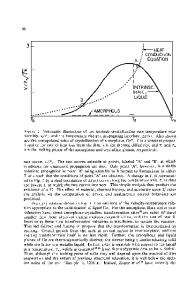Field-Assisted Germanium Induced Crystallization of Amorphous Silicon
- PDF / 493,677 Bytes
- 6 Pages / 612 x 792 pts (letter) Page_size
- 25 Downloads / 340 Views
A16.3.1
FIELD-ASSISTED GERMANIUM INDUCED CRYSTALLIZATION OF AMORPHOUS SILICON J. Derakhshandeh, S. Mohajerzadeh, N. Golshani, E. Asl Soleimani and *M.D. Robertson Thin Film Laboratory, Department of Electrical and Computer Engineering, University of Tehran, Tehran, Iran Tel/Fax: +98 (21) 801 1235, *Department of Physics, University of Acadia, Canada Email: [email protected], ABSTRACT A field-assisted germanium-induced crystallization of amorphous silicon on glass is reported at temperatures below 500oC. Silicon films with a thickness of 0.1um are covered with 500Å of germanium as the seed of crystallization. Applying an electric field enhances the growth from both cathode and anode sides. XRD, SEM and TEM analyses have been used to study the crystallinity of the samples which have been treated under different annealing conditions, all confirming the polycrystalline nature of the annealed silicon films. The value of the applied voltage plays a crucial role in the crystalline quality of Si layers. While samples treated without an external voltage are not polycrystalline, an electric voltage of 10 V applied for a 1cm separation between anode and cathode, seems suitable for achieving good poly-crystalline Si layers. The size of grains varies between 0.1 and 0.2µm, as observed using SEM. INTRODUCTION Polycrystalline silicon has been of significant interest to many researchers for its prospective applications in realizing thin film transistors. Despite the usefulness of such material for large area electronics, its use has been limited to special glasses, mainly due to a high processing temperature needed for crystallization. Several techniques have been introduced to lower the annealing temperature during crystal growth, the most important of which are excimer laser annealing (ELA) and solid phase crystallization (SPC). While ELA is a low temperature process, it requires expensive facilities [1]. On the other hand SPC is energy consuming and requires temperatures above 550oC [2]. Metal induced crystallization (MIC) has been successful in reducing the crystallization temperature to values around 400oC [3,4]. Many researchers have attempted various types of MIC to lower the treatment temperature and realize thin film transistors on glass [5]. Metal contamination, however, is a main concern in all of these approaches. Metal induced lateral crystallization is a modified alternative of MIC to reduce the unwanted incorporation of metallic atoms in the growing layer [6-9]. It has been suggested that lateral diffusion of metallic atoms causes the crystallization of amorphous silicon. Also the annealing temperature is slightly above that of MIC. The use of germanium as a clean seed of crystallization has been attempted by Subramanian et.al. [10]. A lateral growth of the order of 0.5µm has been achieved at temperatures above 500oC and small geometry TFT’s have been realized. Insignificant lateral
Downloaded from https://www.cambridge.org/core. HKUST Library, on 22 Jun 2020 at 16:29:13, subject to the Cambridge Core
Data Loading...



